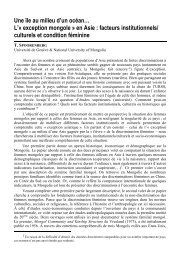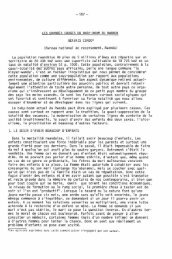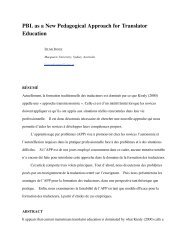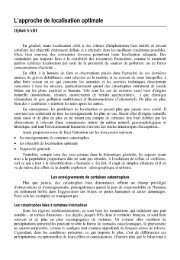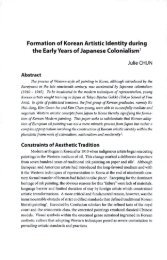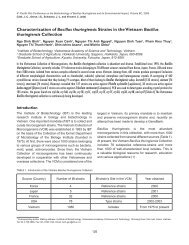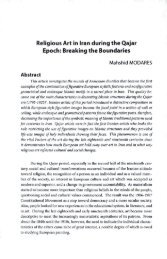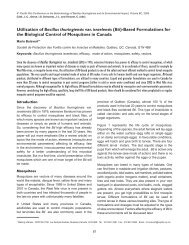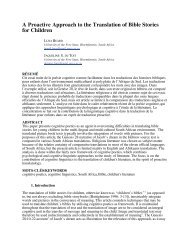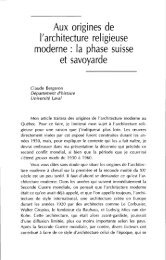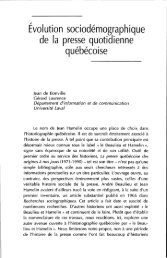Discoursal Function of Phonological Patterns in Poetic Texts ...
Discoursal Function of Phonological Patterns in Poetic Texts ...
Discoursal Function of Phonological Patterns in Poetic Texts ...
You also want an ePaper? Increase the reach of your titles
YUMPU automatically turns print PDFs into web optimized ePapers that Google loves.
text, especially <strong>in</strong> poetry, the border l<strong>in</strong>e between discourse and text or “what is said” and “the<br />
way it is said” disappears and form assumes as much significance as mean<strong>in</strong>g, translation <strong>of</strong> poetic<br />
texts poses a real challenge. To demonstrate this, we shall look at a Persian sonnet analyz<strong>in</strong>g the<br />
way its special rhym<strong>in</strong>g patterns contribute to the discourse process and discuss<strong>in</strong>g the obstacles<br />
encountered <strong>in</strong> their translation.<br />
Translation: an Act <strong>of</strong> “Relay<strong>in</strong>g” not “Convey<strong>in</strong>g”<br />
Accord<strong>in</strong>g to the discoursal view <strong>of</strong> language, mean<strong>in</strong>gs and messages are not carried <strong>in</strong> their pretailored<br />
and ready-made shape by texts; they are <strong>in</strong>teractively and “dialogically” (Bakht<strong>in</strong> 1981)<br />
negotiated by the participants; and texts act only as <strong>in</strong>terface mediators between the producer and<br />
receiver discourse processes. Thus, the message to be negotiated from a text would depend not only<br />
on the text factors but also on the receiver factors <strong>in</strong>clud<strong>in</strong>g the amount <strong>of</strong> orientation background<br />
knowledge.<br />
Translat<strong>in</strong>g as an act with the <strong>in</strong>tention <strong>of</strong> mak<strong>in</strong>g a text <strong>in</strong> one language accessible to the<br />
speakers <strong>of</strong> another language cannot, thus, be def<strong>in</strong>ed <strong>in</strong> terms <strong>of</strong> “replacement” (Lotfipour-Saedi<br />
2000) <strong>of</strong> SL elements (forms and mean<strong>in</strong>gs) by “equivalent” TL ones. Firstly, languages, as<br />
“unique structural systems” (Saussure 1959) cannot all be said to possess the same forms;<br />
secondly, the relationship between “forms” and “mean<strong>in</strong>gs” is not <strong>of</strong> the same pattern; and last<br />
but not least, as noted above, mean<strong>in</strong>gs are not “carried” or “conveyed” by the texts.<br />
On the basis <strong>of</strong> this view <strong>of</strong> language, we def<strong>in</strong>e translat<strong>in</strong>g as an act <strong>of</strong> “relay<strong>in</strong>g” the SL<br />
discoursal conditions to the TL reader so that they (SL text author and TL receiver) can <strong>in</strong>teract with<br />
one another directly and we characterize translation equivalence accord<strong>in</strong>gly along certa<strong>in</strong> “aspects<br />
<strong>of</strong> textual structure” and “dimensions <strong>of</strong> discoursal value” (Lotfipour-Saedi : forthcom<strong>in</strong>g).<br />
Among the aspects <strong>of</strong> textual structure for the characterization <strong>of</strong> translation equivalence (TE),<br />
the follow<strong>in</strong>g can be cited: vocabulary, structure, texture, language variety, extraneous l<strong>in</strong>guistic<br />
choices, prom<strong>in</strong>ent l<strong>in</strong>guistic choices and paralanguage. Any variation <strong>in</strong> any <strong>of</strong> these aspects <strong>of</strong><br />
textual structure and the fact that languages may vary <strong>in</strong> both form and mean<strong>in</strong>g <strong>of</strong> these aspects<br />
should be taken <strong>in</strong>to account by the translator.<br />
As for the dimensions <strong>of</strong> discoursal value, it should be said that texts may vary not only <strong>in</strong><br />
terms <strong>of</strong> any <strong>of</strong> the aspects <strong>of</strong> textual structure (just named above), but also <strong>in</strong> terms <strong>of</strong> the<br />
discoursal values represented by them. In fact, accord<strong>in</strong>g to the discoursal view <strong>of</strong> language, any,<br />
even a m<strong>in</strong>or variation <strong>in</strong> the textual structure, is motivated by the underly<strong>in</strong>g discoursal factors. The<br />
follow<strong>in</strong>g dimensions <strong>of</strong> discoursal value can be named: “degree <strong>of</strong> <strong>in</strong>drectness <strong>in</strong> say<strong>in</strong>g”,<br />
“degree <strong>of</strong> <strong>in</strong>determ<strong>in</strong>acy <strong>of</strong> the message”, “cognitive effect and the degree <strong>of</strong> comprehensibility”<br />
and “literary effect” (Lotfipour-Saedi: forthcom<strong>in</strong>g).<br />
Literature-Text and Literary Effect<br />
Literature belongs to a dist<strong>in</strong>ct universe <strong>of</strong> discourse; this dist<strong>in</strong>ction is ma<strong>in</strong>ly <strong>in</strong> terms <strong>of</strong> the<br />
“dist<strong>in</strong>ct” or rather “special” effect literature-text can produce on the reader. But the “special”<br />
effect <strong>in</strong> literature is due only to the special pattern<strong>in</strong>g <strong>of</strong> language patterns (Hasan 1985). These<br />
special patterns have been isolated by different authors <strong>in</strong> terms <strong>of</strong> graphological, phonological,<br />
syntactic and semantic patterns (Cumm<strong>in</strong>gs & Simmons 1983 & Widdowson 1975). Parallel to<br />
his characterization <strong>of</strong> a text as the embodiment <strong>of</strong> a set <strong>of</strong> discoursal and textual strategies,<br />
Lotfipour-Saedi (1990) describes a literature-text as embody<strong>in</strong>g special discoursal and textual<br />
strategies superimposed upon the ord<strong>in</strong>ary ones. He po<strong>in</strong>ts out three special discoursal strategies,<br />
i.e. <strong>in</strong>direction, dehabitualization and <strong>in</strong>determ<strong>in</strong>acy, which, he says, are represented through special<br />
textual strategies such as rhym<strong>in</strong>g, alliteration, irony, metaphor, structural parallelism. It has been<br />
argued that the special patterns employed by a literary producer would contribute to the literary<br />
effect <strong>of</strong> that text by render<strong>in</strong>g the discourse more <strong>in</strong>determ<strong>in</strong>ate, <strong>in</strong>direct and defamiliar. The focus<br />
<strong>of</strong> this paper will be on the special phonological patterns <strong>in</strong> poetic texts, exam<strong>in</strong><strong>in</strong>g their discoursal<br />
value and discuss<strong>in</strong>g whether / how they can be taken care <strong>of</strong> <strong>in</strong> the translation process.



